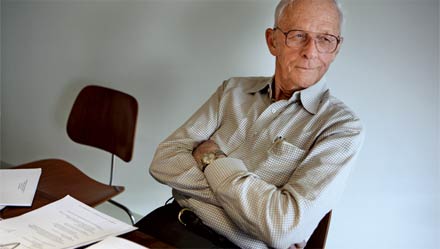The Loop You Can’t Get Out Of
A few words from the father of system dynamics on organizational decision making, human frailty and the reasons that managers trying to solve problems so often just make them worse.
You’ve already looked at the photograph here, so you already know that Jay Forrester must have seen some things. But the legions who’ve built on Forrester’s work would be quick to tell you that it’s not how many things Forrester has seen, but how he’s seen them, that counts. He’s seen them as the most intricate and interactive of puzzles.
The leading question
How does a renowned “systems” thinker look at the challenges of sustainability?
Findings
- The biggest challenge facing leaders: how to manage a successful nongrowing company.
- The biggest problem with how sustainability is being addressed is that we’re treating symptoms, not causes — the same as in most attempts by managers to solve problems.
- The downturn will likely push real sustainability issues to the rear.
Forrester is famously the originator of the field of system dynamics. It’s helpful (not entirely accurate, but helpful) to think of the approach as an extremely grown-up version of the popular computer game SimCity. Here’s Forrester’s description: “System dynamics deals with how the structure of a system and its information flows determine behavior — the control of growth, stability, decay, success and failure. The field focuses on the way internal feedback-loop relationships cause a system to change through time. Understanding why a system behaves as it does permits redesign of structure and policies to improve behavior. … The field combines theory and computer simulation with a very practical application to real-world problems.”
Forrester, now 90 and an MIT Sloan School of Management professor emeritus, joined the Sloan School when it formed in 1956. He was fresh from inventing what we now call RAM (random-access magnetic core memory), and undertook to discover what computers could help us understand about organizations. By the late 1960s he had expanded system dynamics modeling to address the problems of cities (eventually publishing Urban Dynamics) and, after that, world civilization (World Dynamics). It is impossible today not to see these as books about sustainability — maybe among the first great books anywhere about sustainability — even if Forrester wouldn’t call them that. So, as part of an interview series about the intersection of sustainability and management that will begin appearing in January on the new MIT Sloan Management Review Web site, we sought Forrester out.






Comments (3)
Rav Singh
Johnson Walker
kumarsu